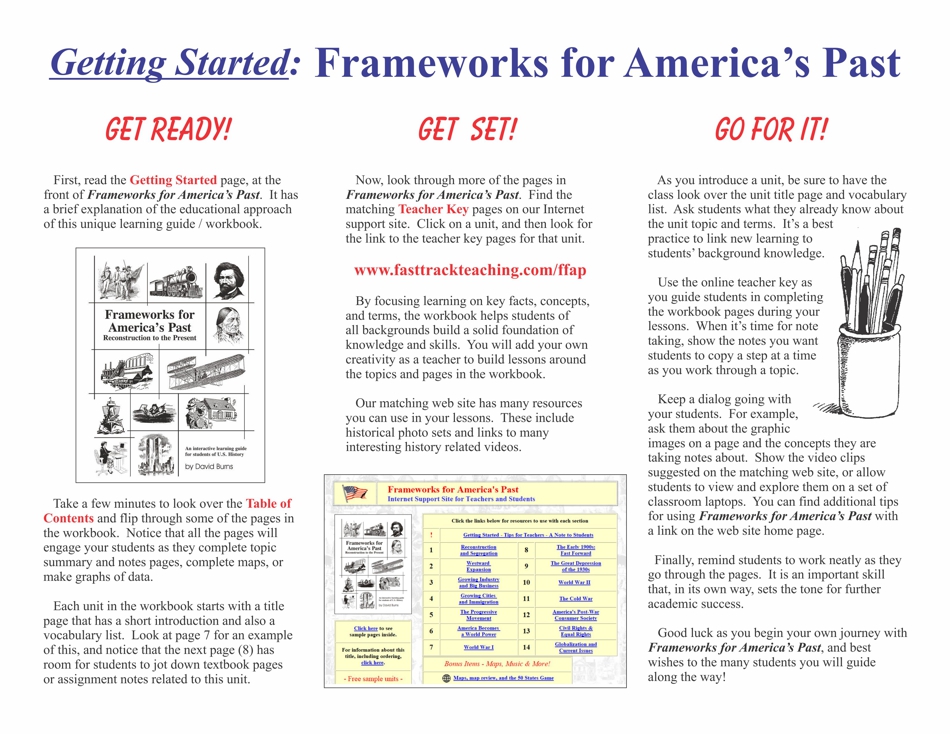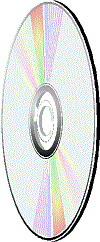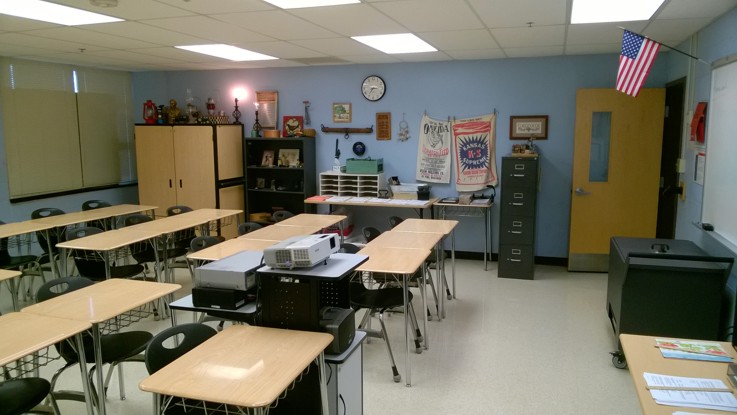| Tips for
Teachers Frameworks for America's Past |
Return
to Originating Page |

|
Frameworks for America's Past: It is always a hectic week getting ready for the start of school, but it is also an exciting time! The students are eager, as anyone can see when the doors open that first day. The look of anticipation in their eyes is testimony to the unique opportunity we are given to play a role in their lives as teachers, administrators, and staff. Always remember that it is an honor to serve in our profession. 1. Job One: Help students get organized as school begins! Download and make copies of the supply list handout (click here for PDF file - print it "actual size") to show students how to set up their history class binder with dividers and tabs. Tell students that they can make their own dividers and tabs from construction paper, or buy ready-made dividers. Each new unit packet will go in the New section, and the completed unit will be moved to the Old section. The States and Regions Map, the Twenty Cities Map, and the World Map (see the Appendix of your binder with the master pages) go in the Maps section. If students have projects to work on, they go in the Other section. Some lined notebook paper should go in the Paper section. 2. Get the unit packet pages ready to go! The page numbering is set up for the student unit packets to be photocopied double sided. That way the unit title page, outline, and most maps will be on the right hand side of open student binder pages. Use pastel yellow paper, if possible, for the title page and (on the back) the list of pages. That will help indicate the starting page of each unit, with its introduction and vocabulary list. The page list has a space where teachers, students, or parents can check off as each page / topic is completed. Hole punch the pages for the first unit, and set them out for students to pick up assembly line style. Have them put the packet in the New section.  3. Begin by linking to what
students already know. 3. Begin by linking to what
students already know.The starting page of each unit has a short overview that should be read aloud in class, with students highlighting some key points. Then, ask students to check off any words in the vocabulary list they already know something about. It is a good way to activate prior knowledge, and interest students in what lies ahead. 4. Use the Internet support site to get students interested and involved. Each unit has collections of historical photo sets, links to short videos, and many other resources. Work these into your teaching and classroom activities. Use a variety of methods, such as direct instruction, individual work, and group activities. Remind students that throughout the year, they should complete any maps by using the same colors as shown on the Internet site, and should shade land and water areas very lightly! An engaging way to introduce students to the Internet support site at the start of the year is with a scavenger hunt. Download one here, print the PDF file "actual size," or create your own sheet. Make a copy for each student, and set them up on computers. Be sure they have headphones or earbuds.  5. Use great DVD and YouTube video
resources. 5. Use great DVD and YouTube video
resources.One of the "best bang for the buck" resources for U.S. history classrooms is the History Channel DVD set titled America: The Story of US. The three disc set is less than $20.00 on Amazon. It has many superb segments that help bring the past to life and build student interest. There is a list of other recommended History Videos & Movies you can find with a link on the Home Page. Preview videos carefully, then pick the segments that will work best to meet your instructional objectives. Shorter is often better than longer. Don't show boring or confusing segments at all. If you show video clips longer than about eight or ten minutes, pause the playback at intervals to emphasize a point or ask a few questions to check for student understanding. Start building your own collection of classroom video hits. Create a three ring binder with dividers organized by unit. Each video you preview gets its own page (or pages, for longer videos). Jot down running notes of the content, with the timing of the various scenes / segments from the head of the video. Mark the best parts with a highlighter. As that notebook grows it will improve your classroom year after year! 6. Be an inspiration! As a teacher, your job is not primarily to create future historians or Ivy League graduates. A much more vital purpose is to help all students find meaning and purpose in their own lives through lessons found in the story of the past. Events and dates are important, but more important are lessons such as these that history reveals: that life is joyous; that life is a struggle; that we create our own destinies; that we are part of larger patterns inherited from generations gone by. Share with students stories from the past that carry our civilization's values and point the way to a worthy life. Tell your own personal stories. Let people from America's past and present share their inspiring words with your students. Students want help finding the path to a good life - don't leave them hanging. Here are two examples of thought-provoking short videos you can find online: Rev. Martin Luther King's advice for middle school students - Click here A man has "No Arms, No Legs, No Worries" - Click here 7. Get your classroom Audio/Visual game on! Great videos won't impress students if the picture or sound quality is below par. Don't project your videos on the classroom white board - it shows bad glare to the students near the center of the room, and won't show the video very well to anyone. Use a pull down screen, and adjust for the largest clear / bright image possible. Daylight from windows will wash out the screen image, so be sure you have blinds, curtains, or some other way to darken the room. Be sure the seat layout allows all students a good view. There is a link from the Home Page that will give you suggestions for setting the best screen resolution of your LCD projector. Sound matters just as much as the video image. A small stereo amplifier and a set of speakers will lift the presentation from blah to WOW! Those speakers in the LCD projector itself can't fill a classroom. The little speaker sets meant for desktop computers at home are not much better. You don't need to spend a lot - check with parents who might have an old amplifier or pair of speakers sitting in a closet, or get a deal at a local thrift store. Here's a diagram for an LCD projector setup with lots of flexibility: You can download (PDF format) and print this diagram by clicking here. 8. Begin each class with a warm-up activity. Have three to five review questions (fill in the blank or short answer) on the board or big screen that students can answer on paper as soon as they arrive. This gives students a specific, every day routine that helps them get settled and focused, and it gives you time to take attendance. Let them use their notebook binders to find any answers they don't know. Let them make corrections as you go over the answers. That way every class starts with success, and with everyone tuned into key points from the previous lesson. Be sure to add a positive comment as you finish the warm-up: "Great, it's good to see everyone today, and that everyone is up to speed with yesterday's lesson." You can download a warm up sheet (PDF format) good for 6 class days by clicking here. It is also a good idea to end each class with either a written "exit ticket" or a few verbal questions to reinforce key points before the bell. Example: "Anyone in these two rows: Who was the key leader in Great Britain during World War II?" "Winston Churchill!" "Great, next two rows . . ." Before dismissing students, be sure to end on a positive note: "I really appreciate that everyone was on time and attentive today," or "Good questions and comments today - I enjoyed it! See you tomorrow!" Students will learn more and connect to your class better if they get out to where history was made, and to places where the past can be seen and touched. Have a handout ready for "Parents' Back to School Night" - a sample is shown on the right. (To download it in PDF format, click here.) Give copies to your students also. Offer extra credit for museum visits, but explain that students who want the credit must create something to show the class: a poster, a digital slide show, or a short highlights video. If they want to bring friends and make it a group event, that's even better - as long as the parents approve. 10. Don't forget to have fun! No one is going to enjoy a history class without some excitement, suspense, and fun. Make time to work in activities, videos, projects, music, and stories that students will still be talking about when they get home. If you have a class set of computers, consider making "web quest" work sheets that engage students in the current unit's historical photo sets and other links. They will need headphones or earbuds for the video links, of course. Now and then, allow "Students' Choice" time on the computers, encouraging them to freely explore any units / topics / links they are interested in anywhere on the class web site. If you have your own classroom, consider making a mini-museum of items that lend an historical feel to the space. Old artifacts make great "hooks" as you start a unit, and can help with teaching about many specific topics. Best of all, students love touching and asking about objects on display! Below: A classroom showing a
60 inch wide pull down screen and LCD projector arrangement. This
size works well for showing standard format (4:3 screen ratio) videos
and web sites. A 72 inch wide screen, however, will offer better
visibility for videos with wide screen (16:9) format.
 Below: This classroom
collection of historical artifacts includes railroad
spikes, a vintage coal miner's lunch bucket,
wheat from the Great Plains, lanterns that once
used Standard Oil kerosene, a flour sifter, and a woman's
apron hand made from feed bag cloth in the 1930s. Some
of the other items: a
(reproduction) 1902 Sears catalog, an old style washboard, an iron
horseshoe and farm tools made by a blacksmith, steel bolts, 78 and 45
rpm
records, lumps of coal, copper ore, bobbins
from a textile mill, (reproduction) Edison style light
bulbs, a Shaker sewing box, and old machine tools.
 |
|
Copyright Notice
Copyright 2009,
2023 by David Burns. All rights
reserved.
|